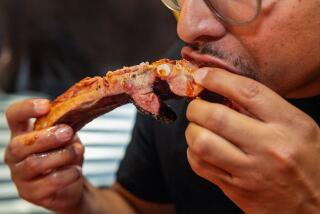Of Meat and Money : Auctioned Farm Animals Turn Profits and Make Future Meals
- Share via
Denise Beck didn’t mince words about what she and her husband plan to do with the shiny black steer named Stew that they bought Friday at the Ventura County Fair.
“We’re going to have a barbecue,” Beck said. “And Stew is it.”
And the Fillmore teen-ager who raised Stew knows just what he’ll do with the nearly $2,000 Denise and Jim Beck paid. Mike Campbell, 17, said he plans to buy a race car.
The son of Fillmore City Councilman Roger Campbell, Mike shrugged off any concerns about the fate of the 1,100-pound steer he has raised for months.
“It’s an animal to be eaten, not a pet,” he said.
Such practical attitudes prevailed at the junior livestock auction Friday.
For Mike Campbell and other members of 4-H and Future Farmers of America clubs, the annual auction is the culmination of months of feeding, grooming and exercising their goats, lambs, pigs and steers.
It’s the young people’s chance to get back the hundreds or thousands of dollars they have spent to buy and raise the animals--and maybe earn a little profit to boot.
For the adults who crowd into the fair’s livestock tent to bid on the beasts, the auction is a chance to show support for the youth organizations.
But it’s also an an opportunity for businesses to advertise and boost their public image. For example, Jim Beck bought the steer on behalf of his firm, Seneca Resources, which plans to grill it at a company party.
Even ordinary citizens see the auction as a chance to impress their friends.
“It’s called bragging rights,” said Bruce Rosenauer, who paid nearly $3,500 Friday for a pig raised by the daughter of a friend. “That’s all it is.”
If buyers at the auction wanted only meat, they would go elsewhere, fair officials said.
Steers, for example, sell for 69 cents a pound on the wholesale market, compared to $1.50 and up at the auction.
“No one is coming down here to buy dinner,” said the Craig Fosdick, the fair’s assistant superintendent for large livestock.
Indeed, many of the businesses that bid premium prices for steers and other livestock immediately resell the animals to meat buyers, said Vic Briggs, superintendent for large livestock.
Although such companies recoup only a fraction of their costs, they can write off the rest as an advertising expense, Briggs said.
Traditionally, local politicos have joined the bidding, including Rep. Elton Gallegly (R-Simi Valley), former Rep. Robert J. Lagomarsino, and some county supervisors. But this year, Ventura City Councilman Jim Monahan was the only elected official seen at the auction, fair officials said.
“You see them election years a lot more than you do off years,” Briggs said.
At last year’s auction, with the November election barely two months away, Gallegly and his opponent, Anita Perez Ferguson, each paid more than $500 for a hog.
Reached at his Oxnard office Friday afternoon, Gallegly said he was too busy to attend this year. But he said the auction is more than an election-year tactic.
“You do it because you believe in it,” he said, “not because it’s politically expedient.”
Some bidders left with something entirely different than they expected.
Moorpark residents Steve Patton and Scott Husted said they came to the auction this year for the first time, thinking they would show support for 4-H by buying a pig, most of which cost several hundred dollars.
But the two men got caught up in the bidding for the championship steer, a massive 1,223-pound beast raised by Ventura teen-ager Bret Haley.
Their bid of $7 per pound won them the steer at a total price of $8,561, making the animal the priciest purchase of the day.
“It was just kind of a heat-of-the-moment thing,” Patton said.
Some veteran auction-goers know how expensive such impulse buying can be.
Harvey Hooten, owner of an Oak View feed store, said he comes to the auction every year to buy animals raised by his customers’ children.
But Hooten said he’s learned to avoid the alcohol that flows at the auction bar from 9 a.m. on.
Wearing a white straw cowboy hat, like most men at the auction, Hooten stood nursing a glass of Bloody Mary mix--minus the vodka.
“You get too much alcohol, the price might go up,” Hooten said. “That’s why I stay with the mix.”
* SCHEDULE OF EVENTS: B3
More to Read
Sign up for Essential California
The most important California stories and recommendations in your inbox every morning.
You may occasionally receive promotional content from the Los Angeles Times.













